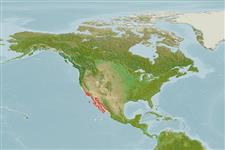分類 / Names
俗名 | 同種異名 | Catalog of Fishes(屬, 種) | ITIS | CoL | WoRMS | Cloffa
Elasmobranchii
板鰓亞綱 (鯊魚與魟魚) (sharks and rays) >
Rhinopristiformes (Shovelnose rays)
鰩目 (Shovelnose rays) >
Rhinobatidae (Guitarfishes)
琵琶鱝科 (Guitarfishes)
More on author: Ayres.
Environment: milieu / climate zone / 深度上下限 / distribution range
生態學
海洋; 半鹹淡水 居於水底的; 深度上下限 1 - 91 m (Ref. 48844), usually 1 - 13 m (Ref. 48844). 熱帶; 38°N - 18°N, 123°W - 106°W (Ref. 114953)
Eastern Pacific: endemic to the eastern Pacific from San Francisco, USA to the Gulf of California, and possibly to Mazatlan, Mexico (Ref. 48844).
東太平洋: 來自舊金山的東太平洋的特有種, 美國到加州灣, 與可能地到墨西哥馬瑞它.(參考文獻 48844)
Length at first maturity / 大小 / 重量 / 年齡
成熟度: Lm ?, range 57 - ? cm
Max length : 119 cm TL 雄魚/尚未辨別雌雄; (Ref. 48844); 170.0 cm TL (female); 最大體重: 9.8 kg (Ref. 40637); 最大體重: 9.8 kg; 最大年齡: 16 年 (Ref. 48844)
Broad disc is greater in length than width; a relatively smooth dorsal surface except for a single row of thorns around the eyes and extending along the back and tail; a long, pointed snout with a rounded tip; small, rounded, pebble-like teeth; a first dorsal fin that originates closer to the pelvic fin base than to the caudal fin origin; a thick tail and a moderately large caudal fin without a distinct lower lobe. Tooth count: 102-112/98-117. Spiral valve count: 8-10.
Body shape (shape guide): elongated.
寬的體盤是長度大於寬度; 一個相當平滑的背面除了一個單列的刺眼睛四周,而且延伸沿著背面與尾部; 長, 尖的吻具有一個圓形的頂端; 小的﹐圓形的﹐和卵石狀的齒; 一個超過到尾鰭起源起點較靠近腹鰭基底的第一背鰭; 一個厚的尾部與一個普通大的尾鰭沒有明顯的下葉。 牙齒數目: 102-112/98-117. 螺旋瓣數目: 8-10.
Found on sand or mud bottoms of bays, seagrass beds, estuaries, and near rocky reefs. Nomadic and gregarious. Found singly or in aggregations (Ref. 12951). Burrows in sand during the day, feeds on crabs, worms, clams and small fishes at night (Ref. 12951). Ovoviviparous, with 6 to 28 pups in a litter (Ref. 48844). Females mature by 7 years at 87-99 cm TL; males reaches 91-110 cm TL; birth size at 20-24 cm TL (Ref. 114953).
Etymology: The genus comes from the Greek word rhine, meaning shark, and the Latin word batis, meaning ray, in reference to its body form being intermediate between that of a shark and a ray. The species name comes Latin, meaning produced, in reference to its pointed snout (Ref. 48844).
棲息於海灣,海草床,河口與鄰近岩礁的沙或泥底部了。 流浪性而群居的。 各別地發現或聚集成群.(參考文獻 12951) 穴居在沙中在白天期間, 吃螃蟹,蠕蟲,蛤與小魚在晚上.(參考文獻 12951) 卵胎生的,6 到 28個幼胎一胎.(參考文獻 48844)
詞源: 本屬來從希臘的字 rhine, 意謂意謂鰭條的鯊魚, 與拉丁文的字 batis, 關於介於鯊魚的與一個鰭條之間的它的體型。 此魚種名稱來拉丁文,意謂生產, 關於它的尖吻.(參考文獻 48844)
Life cycle and mating behavior
成熟度 | 繁殖 | 產卵場 | 卵 | 孕卵數 | 仔魚
Exhibit ovoviparity (aplacental viviparity), with embryos feeding initially on yolk, then receiving additional nourishment from the mother by indirect absorption of uterine fluid enriched with mucus, fat or protein through specialised structures (Ref. 50449).
Adults of both sexes congregate during the breeding season in shallow bays and estuaries and likewise leave when the pupping season is over after mating (Ref. 48844). Gestation lasts for about 12 months (Ref. 48844).東太平洋: 來自舊金山的東太平洋的特有種, 美國到加州灣, 與可能地到墨西哥馬瑞它.(參考文獻 48844)
Eschmeyer, W.N., E.S. Herald and H. Hammann, 1983. A field guide to Pacific coast fishes of North America. Boston (MA, USA): Houghton Mifflin Company. xii+336 p. (Ref. 2850)
IUCN 瀕危狀態 (Ref. 130435: Version 2025-1)
近危 (NT) ; Date assessed: 17 December 2014
人類使用
漁業: 商業性; 游釣魚種: 是的
工具
特別的報告
下載 XML
網路資源
Estimates based on models
Preferred temperature (參考文獻
123201): 15.3 - 25.9, mean 22.4 °C (based on 149 cells).
Phylogenetic diversity index (參考文獻
82804): PD
50 = 0.5020 [Uniqueness, from 0.5 = low to 2.0 = high].
Bayesian length-weight: a=0.00209 (0.00137 - 0.00319), b=3.10 (2.97 - 3.23), in cm total length, based on LWR estimates for this species & Genus-body shape (Ref.
93245).
營養階層 (參考文獻
69278): 3.6 ±0.3 se; based on diet studies.
Generation time: 11.0 ( na - na) years. Estimated as median ln(3)/K based on 2
growth studies.
回復力 (參考文獻
120179): 低的, 最小族群倍增時間4.5 - 14 年 (tm=7; tmax=11; K=0.1; Fec = 6).
Fishing Vulnerability (Ref.
59153): High vulnerability (65 of 100).
🛈
Nutrients (Ref.
124155): Calcium = 32.6 [8.1, 140.3] mg/100g; Iron = 0.666 [0.163, 1.807] mg/100g; Protein = 18.8 [16.7, 20.7] %; Omega3 = 0.146 [0.065, 0.333] g/100g; Selenium = 50.9 [14.7, 138.9] μg/100g; VitaminA = 12.1 [5.5, 26.8] μg/100g; Zinc = 1.03 [0.51, 1.86] mg/100g (wet weight);
